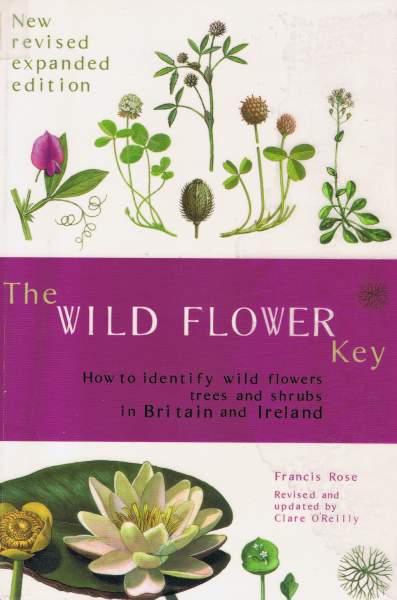Je viens de recevoir le fameux livre de Rose (nouvelle édition) et il me laisse une très bonne impression. Reste bien sûr à l’utiliser sur le terrain.
Toutefois, à chaud et après consultation de l’index des taxons traités et bien que (contrairement à la précédente éditions) les taxons du nord-ouest de l’Europe ne soient pas traités, il est tout à fait opérationnel pour la Bretagne (au moins au début).
A ma connaissance il n’y a pas d’équivalent pour débuter (sauf la flore « blanche » de Géhu, une flore très accessible « bricolée » sur la base de la flore de Belgique, mais qui n’existe plus…) car il semble très pédagogique et accessible (sachant lier des clefs performantes et des dessins de familles et genres de qualité). Et le « barrage » de la langue n’en est plus un, car il initie le débutant aux usages futurs de la Flore tel que la « Stace » et surtout Flora Europaea (Flora Europea – 5 vol.: Lycopodiaceae to Orchidaceae, TUTIN T. G., HEYWOOD V. H., BURGES N. A., VALENTINE D. H., WALTERS S. M. et WEBB D. A., 1964-1980, Cambridge University Press).
Petit cerise elle contient une clef (non réactualisée par rapport à la précédente édition) des formes végétatives des taxons par types « d’habitat ».
Attention elle ne traite pas les « Graminoïdes », pour cela et toujours vous familiariser avec l’anglais, il y a par exemple : « Sedges of British isles » de JERMY chez BSBI, ou « Grasses, a guide to their Structure, Identification, Uses and Distribution in the British Isles » de HUBBARD chez Pelican Books (+ correctifs de CHICOUENE D.).

The Wild Flower Key de Francis Rose, revised an updated by Clare O’Reilly
- un livre de 576 pages aux éditions « Frederick Warne »
- la première édition date de 1981 et la présente édition est de 2006.
Synopsis :
« This highly acclaimed field guide to British and Irish wild flowers has beenthoroughly revised, with many new illustrations and additions, including a completely revised text. Covers over 1,600 species »
« This wild flower identification guide was first published in 1981 and is still widely accepted as the best of its kind for its combination of meticulous illustrations and the use of keys to aid recognition. For this new edition, the Latin names have been revised in accordance with the current classification system. It is now published as the ideal book for the serious student of British and north-west European wild plants, providing a bridge between picture identification guides and the non-illustrated academic floras. »
Vous pouvez le commander à Dialogue – Brest (compter 4-6 semaines de délais, mais il y aussi Amazon avec les risques inhérents à l’usage de la Carte bancaire…) au prix de 30 € 40 (2009).
Les références exactes sont :
- Editions : Frederick Warne; Rev Ed edition (30 Mar 2006)
- Langage : Anglais
- ISBN-10: 0723251754
- ISBN-13: 978-0723251750
Customer Reviews :
- Source : http://www.amazon.co.uk
- How this edition differs from the old edition, 24 Nov 2006
- Reviewer: Mrs. C. L. O’reilly « Clare O’Reilly » (Durham, UK) – See all my reviews
The second edition of this classsic guide has been long coming: in 25 years since the book was published, many people are surprised to learn that there have been many changes to our knowledge of wild plants.
Many features used in identification have been shown to be inaccurate. Scientific names have changed. Many non-native species have become relatively widespread.
This second edition does differ dramatically from the first, but it’s all in the detail :
- there are over 100 new line drawings of diagnostic parts of plants;
- there are 150 new colour plant portraits;
- over a third of the genera keys have been re-written as many did not work!
- national referees (i.e. top experts) have written keys for difficult groups such as willowherbs and water-starworts;
- there are completely new keys, which did not appear in the old edition e.g. to fine-leaved mayweeds;
- the new introduction is twice as long, with much additional information to assist beginners;
- the new glossary is three times as long, packed with new line illustrations;
- there are new features to assist those working in conservation, such as marking plants as BAP species and with their protected species and/or red list status;
- there is a compilation of the lastest research on ancient woodland indicator species;
- the new edition includes extra identification tips, from the new author’s experience and from specialist publications like Plant Crib, not published in any other field guide.
This book is not really a competitor with the Fitter and Blamey books, as suggested by reviews here – it goes beyond just ‘picture matching’ and is the only book to bridge the gap between picture guides and non-illustrated, academic floras. Plus I have to say, the illustrations in the latest Fitter and Blamey book (2003) are mostly dreadful! There are many errors, sometimes just a bit misleading (e.g. meadow buttercup lower leaf) to unidentifiable blobs (e.g. purslane) to pictures of completely the wrong plant (e.g. narrow-leaved ragwort (it should have linear leaves!!)
In case anyone thinks I am biased as author of the new edition, please note that I revised the book because I got fed up with teaching using the old, out of date edition, and I do not get royalties!
En résumé une excellente entrée en matière. Après viendrons les Graminée et Carex…
Bonne lecture
CC BY-NC-ND
